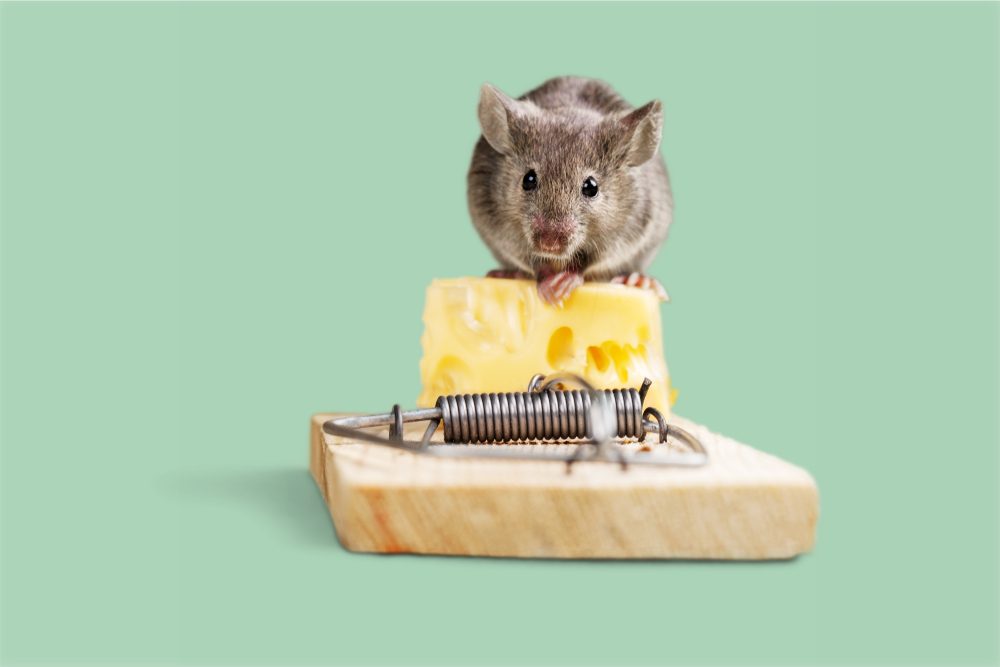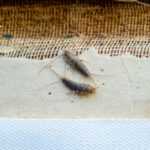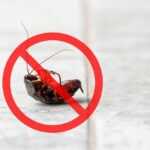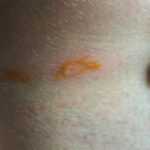Top 5 Mouse Trap Tips to Stop Mice in Their Tracks
Got a mouse problem? Choosing the right mouse trap is key. This guide will help you pick the best traps, bait them correctly, and set them up to keep your home mouse-free.
- Different types of mouse traps (snap, glue, electronic) work best in varying situations, so choose based on your needs.
- Baiting traps with strong-smelling options like peanut butter or chocolate increases catch success; avoid using too much bait.
- Regularly check and clean traps to maintain their effectiveness and ensure they’re safe for kids and pets.
Understanding Mouse Traps
Mouse traps are essential tools in rodent control. These tools come in three primary types: snap traps, glue traps, and electronic traps. Each type has its own unique mechanism and level of effectiveness, making them suitable for different situations. A mousetrap is an essential rodent control device, valued for its efficiency and versatility in both residential and commercial settings. Choosing the right type can significantly impact your ability to keep your home mouse-free.
Mouse traps are essential not only for capturing and killed mice but also for reducing the need for harmful poison. This is especially important if you have pets or young children in the house, where a house mouse might be present. Mousetraps and a rat trap can provide an effective solution in these situations. These traps are reliable pest control products for home use, offering safety and convenience.
Let’s explore the specifics of each type of mouse trap to help you make an informed decision.
Snap Traps
Snap traps are perhaps the most well-known type of mouse snap trap. They work by using a spring mechanism that delivers a quick, lethal blow to the mouse when triggered. The force of the spring ensures a quick kill, while the trap is designed to hold the mouse securely after activation. They are highly effective for rapidly reducing mouse populations in your home.
For the best results, place snap traps along walls where mice are known to travel, with the trap facing the wall. This positioning takes advantage of the mouse’s natural tendency to follow along walls, increasing the likelihood of a successful catch. When a mouse pulls on the bait, it triggers the trap mechanism.
Glue Traps
Glue traps offer a different approach to rodent control. They use a sticky surface to immobilize mice when they step on it. While effective in capturing mice, these traps do not provide a quick death, which can be a drawback for some homeowners.
However, glue traps can be useful in specific situations, especially when snap traps are not viable. They are best placed along known rodent pathways and under appliances where mice are likely to travel.
Electronic Traps
Electronic traps are a modern and humane option for rodent control. These traps kill mice instantly with a high-voltage shock, ensuring a quick and painless death. Designed for easy disposal, they allow you to remove the trapped mouse without direct contact.
One of the major benefits of electronic traps is their reusability, making them a cost-effective solution over time. For a clean and efficient solution to handle mice, electronic traps are worth considering.
Choosing the Right Bait
Selecting the proper bait is key to the effectiveness of your mouse traps. The type of bait you use can significantly impact how effective your traps are at catching mice. Interestingly, mice are more attracted to high-protein and high-fat foods than the stereotypical cheese. Their hunger drives them to seek out these foods, making them more likely to approach a well-baited trap. For best results, load a small amount of bait onto the trap to ensure mice cannot steal it without triggering the mechanism.
We’ll explore popular bait options and share homemade bait ideas to maximize your trap’s effectiveness. When placing bait, pay attention to the distance between the bait and the trap’s trigger—placing the bait too far from the trigger may allow mice to eat without setting off the trap.
After setting your traps, wait a few days to see if mice are caught before making changes. If no mice are caught after several days, we recommend checking and adjusting the bait to improve your results.
Popular Baits
Peanut butter tops the list as one of the most effective baits for mouse traps. Its strong aroma, sticky texture, and high sugar content make it irresistible to mice. A small dollop on your trap can significantly increase your chances of making a catch.
Other effective baits include hot dogs and chocolate, both of which have strong scents that can lure mice towards the trap. While cheese is a traditional choice, it’s not as effective as sweeter or fattier foods.
Avoid using excessive bait, as overloading your trap can allow the mouse to take the bait without triggering the mechanism.
Homemade Bait Ideas
If you prefer a DIY approach, homemade baits can be just as effective. One popular combination is peanut butter mixed with oats or chocolate, which appeals to mice’s taste preferences. This mix is easy to prepare and can be highly effective.
Birdseed and nuts are also excellent homemade bait options, as mice are naturally inclined to eat seeds in the wild. This can be particularly useful if you’re looking for a more natural bait option.
For those who enjoy baking, a dough made from flour, sugar, and a bit of chocolate can also serve as an effective homemade bait. The sweetness attracts mice, and the sticky texture makes it difficult for them to steal the bait without triggering the trap.
Setting Up Your Mouse Trap
Properly setting up your mouse trap is essential for its effectiveness. Each type of trap has specific setup procedures that need to be followed to maximize their potential. Some people build their own traps to suit specific needs, using different materials and designs for better results. Proper setup not only increases your chances of catching mice but also ensures the safety of your household.
We’ll cover placement tips and safety precautions to keep in mind when setting up your traps. These tips will help you create a more effective and safe environment for rodent control, including using gloves or keeping your hands protected when handling traps.
Placement Tips
The placement of your traps is just as important as the type of trap you use. For maximum effectiveness, traps should be placed along walls and in corners where mice typically travel. Additionally, consider placing traps inside cabinets or behind appliances to target mice where they are active inside the house. This leverages their natural behavior, enhancing the chances of a successful catch.
Snap traps, for instance, should be positioned in dark areas where mice are likely to hide, such as behind furniture or near the edge of surfaces where mice travel. Glue traps, on the other hand, are most effective when placed along known rodent pathways and under appliances.
Placing multiple traps in different locations can improve your chances of capturing mice. Mice are intelligent and cautious animals, so having several traps can help ensure that at least one will be in the right place at the right time.
People often make common mistakes like setting traps in open areas where mice are less likely to travel. Placing traps near walls, corners, and areas with noticeable mouse activity can greatly improve your chances of success.
Safety Precautions
Prioritize safety when setting up mouse traps. Keep traps out of reach of children and pets to avoid accidental injuries. This is especially important if you’re using snap traps or electronic traps, which can cause harm if triggered accidentally.
Carefully follow the manufacturer’s instructions for safe and effective trap use. When disposing of a trapped mouse, always wear gloves and handle the trap with care to prevent any health risks.
Monitoring and Maintaining Mouse Traps
Regular monitoring and maintenance are crucial once your traps are set. This ensures that your traps remain functional and ready to capture any mice that come their way. Consider running a monitoring setup, such as a camera or software, to continuously observe mouse activity and trap performance.
We’ll discuss the importance of regular trap checks and offer tips on cleaning and reusing traps to maintain their effectiveness. You can also experiment with different monitoring methods to find the most effective way to track and improve your trap results.
Checking Traps Regularly
Regular trap checks are essential to ensure they remain effective and to prevent dead mice from attracting other pests. After setting traps, it is best to wait a few days before expecting results, as mice may take time to approach new traps. Ideally, you should inspect your traps daily, especially in areas where mouse activity is high.
We recommend checking traps every one to two days for best results. By checking traps frequently, you can promptly address any captures and reset them for ongoing monitoring. This not only maintains the effectiveness of your rodent control efforts but also prevents any unpleasant situations that may arise from decaying mice.
Regular inspections also allow you to monitor the wear and functionality of your traps, ensuring they continue to work as intended. Regular inspections allow you to make necessary adjustments to improve trap performance.
Cleaning and Reusing Traps
Cleaning traps is essential for maintaining their effectiveness and ensuring future catches. Clean traps with mild detergent and warm water to remove residue and odors that might deter future catches. It’s important to avoid strong chemicals, as residues can deter mice from being caught in the future.
Ensure traps are fully dry before reusing to prevent mold or odors. Wearing gloves while cleaning can prevent human scent from deterring future catches and protect you from health risks.
Alternatives to Traditional Mouse Traps
Alternative methods can effectively manage rodent problems when traditional traps are not suitable. There are different styles of traps available, each with unique designs and approaches, such as weighted can or ramp traps, offering various levels of stability and effectiveness. Humane traps and rodent repellents offer effective and compassionate alternatives to traditional traps.
We’ll explore humane traps for safe capture and release, and various rodent repellents to keep mice at bay. If traditional traps are not suitable, the best course of action may involve trying humane or repellent options to address the issue.
Humane Traps
Humane traps capture rodents without harming them, allowing for safe release elsewhere. Also known as catch-and-release traps, they are ideal for those who prefer not to kill mice.
There are different models of humane traps, including single-door and multiple-capture types, catering to various needs and situations. They are best set near walls and in out-of-sight locations to align with mouse travel routes.
Humane traps typically use a simple mechanism that triggers upon entry, ensuring quick and safe capture. Once captured, mice can be released back into the wild without causing harm.
Rodent Repellents
Natural substances like mothballs and certain spices can deter mice from entering homes. These natural repellents create an environment that mice find unpleasant.
Chemical repellents, available as sprays and granules, also help keep rodents at bay. These repellents contain ingredients designed to create an unpleasant environment for mice, helping to keep them out of your home.
Natural and chemical repellents both play crucial roles in preventing mice from invading your home. Incorporating these repellents into your rodent control strategy can significantly reduce the likelihood of an infestation.
Common Problems and Solutions
Using mouse traps effectively involves understanding common problems that might arise and how to solve them. Mice are known to jump or climb out of traps, especially from the rim or edge of a bucket, making it important to consider their escape behaviors when setting up your trap. Proper setup of a mouse trap involves understanding mouse habits and the specific trap design to increase trapping success.
We’ll discuss common issues like mice avoiding traps and traps not triggering, offering practical solutions. Additionally, the distance between the bait and the trap’s trigger is crucial—if the bait is too far from the trigger, mice may escape before the trap activates.
One effective idea is to use a ramp or tip mechanism, possibly made from plastic, to improve the trap’s effectiveness and prevent mice from jumping or climbing out. The force with which the trap is triggered and how it is held in place can determine whether mice fall into the bucket and are securely caught. Each piece of the trap, such as the ramp, bucket, and any tipping mechanism, works together to ensure that mice are effectively trapped and cannot escape by climbing or jumping from the edge or rim.
We recommend experimenting with different trap designs and ideas to address common escape problems and improve your overall trapping success.
Mice Avoiding Traps
Mice may avoid traps due to fear of predators or unfamiliar environments. If mice have had negative experiences with traps in the past, they are likely to avoid them in the future.
Using effective bait like peanut butter can increase the likelihood that mice will approach the trap. Adjusting the placement of traps to areas where mice are more active can also enhance their effectiveness.
Regular checks to ensure traps are functioning correctly and remain baited can improve success. Constantly observing and modifying your strategy based on effectiveness leads to better results.
Traps Not Triggering
Mice may become suspicious of traps if they encounter them frequently without being caught. Overloading traps with bait can allow mice to steal it without activating the trap; a small amount is more effective.
Smaller amounts of bait can be more effective than large amounts, as they encourage mice to interact with the trap. Ensuring that traps are functioning correctly and maintained properly can also help in triggering the traps when mice approach.
Effectively managing a rodent problem requires choosing the right type of mouse trap, using the best bait, and strategically placing and maintaining the traps. Snap traps, glue traps, and electronic traps each have their unique advantages and are suitable for different situations. Proper bait selection and placement can significantly improve your chances of catching mice, while regular monitoring and maintenance ensure ongoing effectiveness.
Remember, effective rodent control not only protects your home but also keeps your family safe from the risks associated with mice. If you need professional help, consider reaching out to Gopher Patrol (Southern California). They offer comprehensive pest control services and can provide the expertise needed to tackle your rodent problem effectively.
Frequently Asked Questions
What is the most effective mouse trap?
The most effective mouse traps are snap traps and electric traps, as they’re quick and efficient. If you’re looking for a more humane option, consider catch-and-release traps to evict mice without harming them.
What type of bait is most effective for mouse traps?
Peanut butter is the go-to bait for mouse traps because its strong smell and stickiness really draw in the little critters. It’s super effective!
How often should I check my mouse traps?
You should check your mouse traps at least once a day, especially if you know there’s a lot of mouse activity. This keeps the traps effective and lets you quickly deal with any caught mice.
Are humane traps effective for rodent control?
Absolutely, humane traps are effective for catching rodents without hurting them, so you can release them safely. They’re a solid choice if you’re looking to avoid killing mice.
What natural repellents can I use to deter mice?
You can use natural repellents like mothballs or spices to keep mice away, as they create a smell that mice dislike. Just sprinkle or place them in areas where you notice mouse activity.





